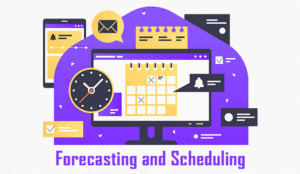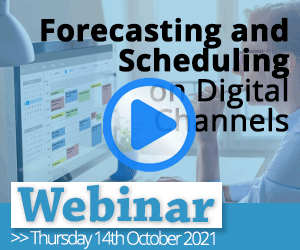Forecasting and scheduling can be complex, but even more so when you factor in digital channels. Here, our readers share their best tips for getting it right – whatever channels your customers are using to get in touch.
Don’t Shy Away From Change and Innovation
Stop doing things the way they’ve always been done and always look for new ways to improve. This can make all the difference to your forecasting accuracy. Here are some readers’ tips to help you shake things up for the better.
1. Improve Your Understanding of Models
One way to get to grips with your data and accurately forecast is to better understand tried-and-tested models – including:
- Understanding time series models (which often outperform causal models).
- Investigating and digging a little deeper to find a causal model that suits. Just don’t forget to have your three assumptions in place before forecasting with one!
- Trying machine learning models.
- Experimenting with SAS, R or Python for more advanced modelling.
- Making a habit of regular reading for personal development. Just make sure you buy the latest editions! Here are two suggestions from Call Centre Helper readers to help get you started:
-
- Forecasting principles and practice – Rob J Hyndman and George Athanasopoulos
- Data Science for Supply Chain Forecasting – Nicolas Vandeput
With thanks to Oscar
2. Have You Tried the Delphi Method Yet?
For new products, use the Delphi Method by asking as many people in the project team to produce forecasts for it.
With thanks to Aaron
3. Watch Out for Extra Volume From Live Chat
Be particularly careful with ROI (return on investment) calculators for Live Chat.
Whilst there may be some deflection from call and email channels, it is quite possible that it will generate extra volume (and costs) elsewhere.
With thanks to Kate
Our article How to Forecast and Plan for Live Chat contains simple lessons for live chat forecasting before presenting a strategy that will help you to plan.
4. Don’t Assume Self-Serve Options Will Be a “Magic Fix”
Be mindful of the potential impact of a channel shift or switching to self-service. This will likely change your total number of enquiries, and may result in a higher average duration for remaining channels.
This may also affect the concurrency capability of the remaining channels when you are planning.
With thanks to Aaron
5. Use an Erlang Calculator
We are a small operation with 10 agents and we utilize the Erlang Calculator on the Call Centre Helper website.
This helps me to calculate current and future forecasting based on new implementations. This has also been huge in allowing me to have proof of the hires we need to make.
With thanks to Susan
Data, Data, Data!!!

Get your data “ducks” in a row
Your forecasting accuracy hinges on the quantity and quality of the data you are using – across all channels.
Therefore, getting to grips with data will always be the best starting point. Here are some tips to help you get your data “ducks” in a row.
6. Start Collecting Data as Soon as Possible!
If you’re not already collecting data to track volumes, do so ASAP. It may take some time to establish – depending on the systems and teams you have in place. However, it will be worth it, as when you need it, you’ll already have a healthy pipeline to draw on.
This can give you a great starting point with historical data. Being proactive this way can also help you to avoid any future projects being delayed by weeks or months while you gather information.
With thanks to Jake
7. Spot Trends and Anomalies
Even when you have lots of data, you should always remember to always question your data.
For example, where does it come from? What does X mean? It will all help you forecast as accurately as possible – and spot trends and anomalies sooner rather than later.
With thanks to Jody
8. Understand Causes of Historical Variation
You’ll risk getting off to a false start if you don’t properly understand your historical data first.
Everything from making sure your historical data is accurate and understanding (in detail) the sources of digital volume data, through to knowing when demand was constrained, can all help here.
Also make a conscious effort to understand any variation in historical volumes, as well as chart historical data and label with causes of historical variation.
With thanks to Ruth
9. Track for Trends and Anomalies
Keep a diary of reasons for variation in digital volumes – making sure to keep separate logs for different channels. This can help you to spot trends and anomalies.
Also, double-check you are applying the terms “Trend” and “Seasonality” correctly.
With thanks to Arthur
Keep a diary of reasons for variation in digital volumes – making sure to keep separate logs for different channels.
10. Graph Forecasts and Actuals
Graph your forecasts next to recent actuals.
Where this isn’t possible, use scenarios to help you get a clearer picture of what might work well.
With thanks to Jo
11. Stop Looking at Overall Volume
Remember when forecasting, don’t just take into account overall volume. Look at all channels individually – including live chat, email, etc…
This will make it easier to highlight channels that are perhaps volatile, or where you need to change your approach to forecasting.
With thanks to Jake
12. Make Detailed Notes Against Spikes – Before You Forget!
It’s easy to forget reasons for spikes or valleys even after a few weeks.
Make sure to record them in as much detail as possible as they happen – otherwise your notes might prove useless later on.
With thanks to Brianne
Don’t Go It Alone!

Forecasting accuracy can often be strengthened by involving more people and data sources in the process
Forecasting accuracy can often be strengthened by involving more people and data sources in the process. This is because it can help to explain and predict trends you may not have previously been aware of. Here are some tips for widening the net.
13. Join Up With Sales and Marketing
Join up with your marketing, sales, service and planning teams for regular planning meetings.
Often forecasts are skewed because of unexpected demand driven by lack of joined-up processes on external communications or website changes. Maintaining open and regular conversation can make all the difference.
With thanks to Garry
14. Ask Your Agents!!!
Don’t overlook the importance of asking for direct feedback from the agents that are operating your digital channels.
It’s highly likely their point of view will differ from your analytical-driven perspective.
With thanks to Brittany
15. Get to Know Your Development Teams
Engage with development teams to understand the roadmap of self-service development, as this may impact your future volumes in a positive or negative way.
With thanks to Aaron
16. Keep a Close Eye on Influential Changes Across the Business
Keep a very close eye on any website changes and/ or changes to customer communications.
Also, try to be conservative with respect to promises of a new system or process across the business – as it might not be the “magic fix” everyone hopes for.
With thanks to June
17. Get Clients and Suppliers Involved Too
It may not be the first thing that comes to mind, but asking your clients and suppliers for their judgement on forecasting (for better or worse) can have a positive impact in the long term.
You should also try and get into the habit of studying any errors and sharing these openly with them. This can all help to build a positive cycle of communication and improvement.
With thanks to Joshua
Getting the Right People
And finally… It doesn’t matter how good your forecasting is, if you don’t have the right people delivering the strategy on the front line, it won’t go to plan.
18. Don’t Assume Everyone Can Do Everything
The best call takers do not necessarily make good chat agents, as different skills are needed to communicate via a written format.
Get to know your agents’ strengths and preferences to make sure you have the right people in the right role. This can help you to fully utilize your team.
With thanks to Sarah
Get to know your agents’ strengths and preferences to make sure you have the right people in the right role.
19. Identify Individuals Whose Actions Contribute to Variation
When you spot anomalies in your data, it can also help to drill down into trends by team member.
When you look at things at this more granular level, you may also be able to identify individuals whose actions are contributing to variations.
This can help you to understand if it’s a people issue, or a wider customer/business issue – before you make alterations to your forecast strategy.
With thanks to John
20. Add an Element of Digital Competency to Your Interview Process
Before they start the role, it can be hard to know how well someone will handle digital communications. A good way to help manage everyone’s expectations from the outset is to have a practical aspect to the interview.
For example, look at how people respond to a customer scenario using a text-based service. Even something like Microsoft Teams would show you how they communicate. It’s also helpful to look for accuracy and the vibe they put out over a digital channel.
With thanks to Sarah
For more on the topic of forecasting and scheduling, read our articles:
- What Is an Erlang Calculator?
- A Guide to Workforce Forecasting in the Contact Centre
- The Latest Techniques for Call Centre Forecasting
- How Do I Calculate… Schedule Adherence?
Author: Robyn Coppell
Published On: 2nd Feb 2022
Read more about - Hints and Tips, Customer Experience (CX), Digital Channels, Forecasting, Omnichannel, Scheduling









































